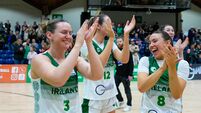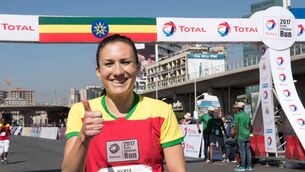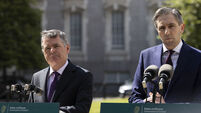Ground gained but media coverage of women's sport falls short of 20x20 target

Republic of Ireland's Louise Quinn, right, and Diane Caldwell watch the 'What's Next for Women in Sport?' conference presented by 20x20 in their team hotel at Sportschule Wedau in Duisburg, Germany. Photo by Stephen McCarthy/Sportsfile
A LOT done but much more to do was the verdict of one of the co-founders of the ground-breaking 20x20 women’s sport movement, which came to its conclusion on Wednesday.
“The train has left the station, the progress is happening here and internationally, but we’re still far from where we want to go,” said Sarah Colgan after research by Nielsen found that improvements in media coverage have only been a fraction of what they had hoped.
Colgan and Heather Thornton of the creative agency Along Came A Spider came up with the original 20x20 idea and got the backing of the Federation of Irish Sport and five major brands (KPMG, AIG, Investec, Lidl and Three).
It began two years ago and aimed to increase participation, attendance, and coverage of women’s sport by 20% by the year 2020.
Findings on its achievements are admittedly skewed by the cancellation of most sport this year, meaning it could only be measured on a single year (2018-2019).
20x20 appears to have had a significant impact on attitudes to women’s sport, as 80% of those surveyed said they were now more aware of it and 61% said they are more likely to support it.
Research also found that 75% of men surveyed said 20x20 had changed their mindset positively towards women's sport.
There was success also on the participation scale, with 42% of women surveyed saying they are participating in more sport and physical activity due to 20x20.
But while there was some improvement in media coverage of female athletes, it was minimal and fell far short of the 20 per cent target.
Online coverage of women’s sport increased by 50 per cent and Irishexaminer.com was one of the leaders in this area but, across the board, only 6% of online sports stories are still about women.
Coverage of women’s sport in print media increased by 53% but is still only at 5%.
And while Irish audience figures for women’s sport on TV almost trebled — from 7% in 2018 to 18% in 2019 — television coverage of women’s sport decreased by 40% in 2019.
RTÉ and TG4's coverage actually increased but 11 television channels were surveyed, and the massive drop was down to the poor coverage on paid sports TV.
RTÉ’S deputy Head of TV Sport Cliona O’Leary said partnering with 20x20 led them to set specific targets for covering women’s sport which they will continue to increase.
“We set up a steering committee and a strategy for women’s sport and engaged with a public service broadcaster in Sweden which started at 25% and now has a 50/50 gender balance in their sports coverage.
“The Olympic and Paralympics output this year would have been 50/50 for 300 hours of output. We’re currently at 14% and we’re aiming at 25% next year.
Because of Covid, RTÉ television broadcast 39 hours of sports 'classics'.
"In the past we would have looked at the 1960s, ‘70s and ‘80s and picked the best matches from then,” O’Leary said. "But, because of our targets, we looked at it with a gender lens and, as a result, 38% of those programmes had women’s sport in them.”











